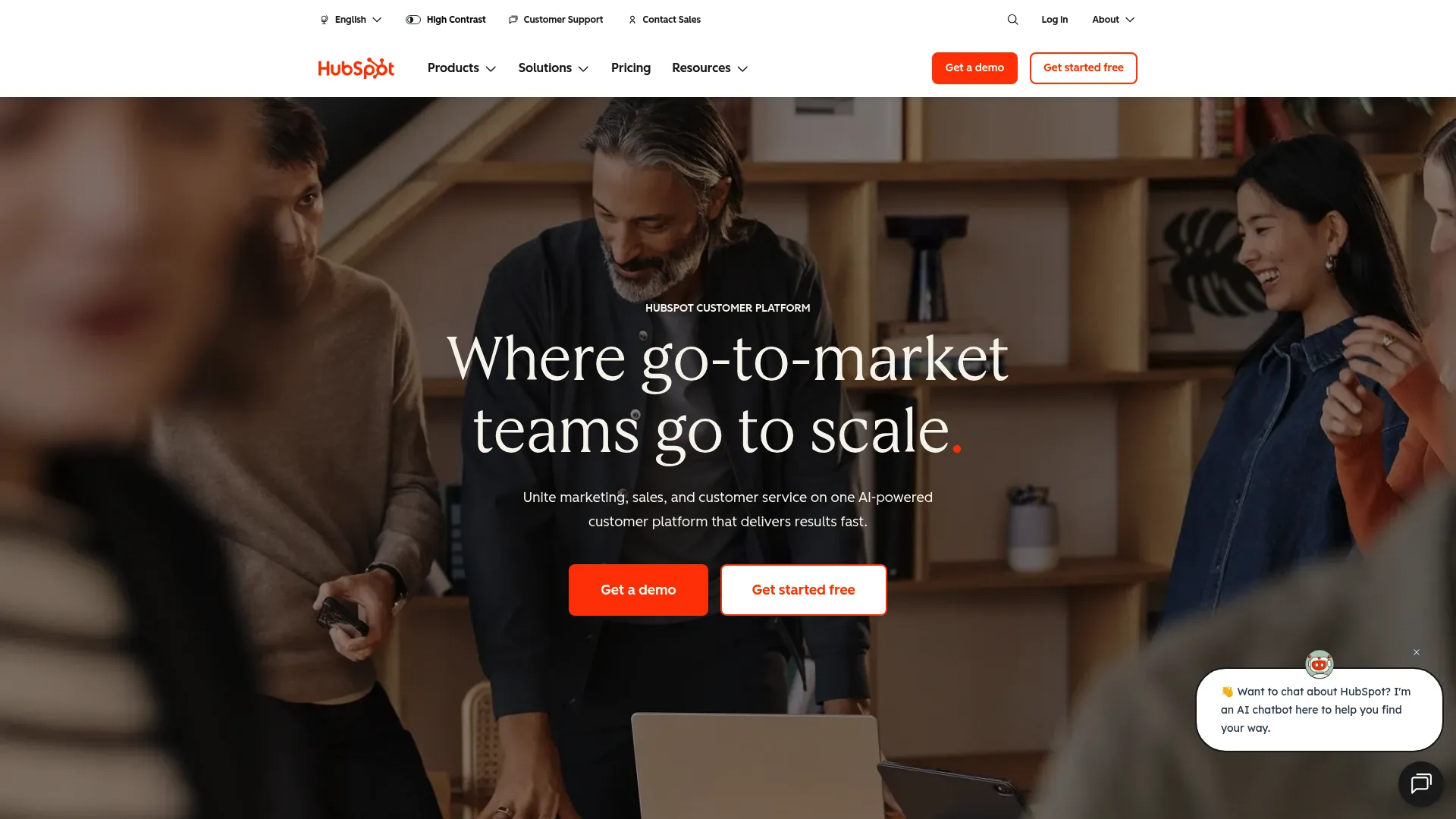
HubSpot Email Marketing Review: The Complete Truth About Features, Pricing & Performance
I’ve been diving deep into HubSpot’s email marketing lately, and honestly, what I found surprised me. Look, everyone talks about HubSpot like it’s the holy grail of marketing platforms, but after spending way too many late nights clicking through every feature they offer (my coffee addiction thanks them), I’ve got some thoughts you probably won’t hear elsewhere.
Here’s the thing – HubSpot’s got some seriously impressive stuff going on, but there are also some pain points that’ll make you want to pull your hair out. Let me walk you through what I discovered so you don’t have to learn the hard way.
Table of Contents
-
TL;DR: Key Takeaways
-
HubSpot Email Marketing
-
Top 4 Alternatives to HubSpot Email Marketing
-
Frequently Asked Questions
-
Final Thoughts
TL;DR: Key Takeaways
HubSpot Email Marketing is pretty solid as part of their whole CRM setup, but man, that pricing structure is brutal – we’re talking a jump from free to $890/month. It’s like shopping for a car and your only options are a bicycle or a Ferrari – where’s the Honda Civic?
The platform’s actually really easy to use (I gave it a perfect 5/5 for CRM integration), but don’t get me wrong, there’s some meh stuff too. The template selection is pretty limited, and the deliverability sits at a decent but not amazing 3.5/5. The free plan gives you 2,000 emails monthly with basic automation, which is honestly legit for small businesses just getting started.
Here’s what drove me nuts: if you want the good stuff like A/B testing and fancy automation, you’ll need deep pockets for that Professional tier at $890/month. Meanwhile, tools like MailerLite and ActiveCampaign give you similar features without breaking the bank.
Bottom line? This works best for bigger companies with complex sales processes who need everything under one roof, not folks just looking for straightforward email marketing.
Criteria Table
|
Criteria |
Score |
Notes |
|---|---|---|
|
Ease of Use & Interface Design |
4.5/5 |
Clean, intuitive interface with smooth drag-and-drop functionality and guided tutorials |
|
Email Creation & Design Capabilities |
3.5/5 |
User-friendly editor with AI assistance, but limited template selection compared to specialized platforms |
|
Automation & Workflow Features |
4/5 |
Visual workflow builder with powerful capabilities, though advanced features require expensive Professional tiers |
|
Deliverability Performance |
3.5/5 |
Solid 84/100 score but not exceptional; domain authentication requires paid plans |
|
Integration & CRM Connectivity |
5/5 |
Strongest advantage with native CRM integration and 1,500+ third-party integrations |
|
Analytics & Reporting |
4.5/5 |
Comprehensive dashboard with industry benchmarking and actionable insights |
|
Pricing & Value Proposition |
2.5/5 |
Generous free plan contrasts sharply with expensive Professional tiers ($890/month) |
|
Customer Support & Resources |
4/5 |
Excellent knowledge base and HubSpot Academy with responsive chat support |
HubSpot Email Marketing
What HubSpot Email Marketing Is Best Known For
HubSpot Email Marketing has built its reputation as the email piece of their massive all-in-one CRM puzzle. What really sets it apart is how everything connects – your email marketing, sales stuff, and customer service all talk to each other. It’s pretty neat, honestly.
Most people know HubSpot for fixing that annoying problem where you’re juggling like five different tools that don’t play nice together. Instead of having your email marketing over here, customer info over there, and sales tracking somewhere else entirely, you get everything in one place. That’s basically their whole thing, and I get why people dig it.

Features That Define the Platform
The drag-and-drop email editor is where most people start, and it’s actually pretty smooth. You just snap content blocks together like digital Legos – no wrestling with weird formatting or trying to get images to line up properly. Setting up my first email campaign took about 10 minutes, and I’m definitely not a tech wizard.
The AI Content Assistant is interesting but not mind-blowing. It’ll help you write subject lines and email copy, which is handy when you’re staring at a blank screen at 2 AM. The suggestions are useful enough, though don’t expect it to write your next viral campaign.
The visual workflow builder for automation is where things get fun. You can set up emails that send automatically when people do certain things – like signing up for your newsletter or abandoning their cart. The visual setup makes it pretty clear what’s happening, even if you’re not super technical. But here’s the catch – the really cool automation stuff is locked behind those expensive tiers I mentioned.
The CRM integration is honestly where HubSpot shines. You can see everything about your contacts – every email they’ve opened, every page they’ve visited, every conversation they’ve had with your sales team. It’s like having a crystal ball for customer behavior.
A/B testing exists, but you’ll need that $890/month plan to use it (ouch). You can personalize emails based on who’s reading them, which is pretty slick. The analytics dashboard shows you how your campaigns stack up against industry averages, which I actually found super helpful.
Pros
All-in-One Platform Integration
The way everything connects in HubSpot is genuinely impressive. I can track someone’s entire journey from the first email they open to when they become a customer and beyond. No more digging through three different systems to figure out what happened with a lead – it’s all right there.
Generous Free Plan Offering
2,000 emails monthly with 100 marketing contacts plus basic automation – that’s actually useful stuff, not just a tease. Most other platforms either don’t have free plans or they’re so limited you can’t do anything real with them. HubSpot’s free version actually works for small businesses.
Exceptional User Experience
Look, I’ve used a lot of clunky marketing tools, and HubSpot isn’t one of them. The interface makes sense from day one, and they actually walk you through setup without making you feel stupid. Everything’s laid out logically, which is rarer than you’d think in this space.
Powerful CRM Integration
This is where HubSpot really flexes. You get complete interaction histories, deal stages, support tickets, and behavioral data all in one view. It transforms how you think about customers – you’re not just looking at email opens anymore, you’re seeing the whole picture.
Comprehensive Analytics Dashboard
The reporting goes way beyond basic open rates and clicks. You get industry benchmarks, health insights, and detailed campaign breakdowns. The benchmark comparisons are particularly valuable – finally, context for whether your 25% open rate is actually good or terrible.
Cons
Expensive Paid Tier Pricing
Here’s where I get frustrated with HubSpot. That jump from free to $890/month is just brutal. It’s like they forgot about all the businesses that need more than basic features but can’t afford enterprise pricing. So many companies get stuck in this weird middle ground.
Limited Template Variety
I’m not gonna sugarcoat this – the template selection is pretty meh compared to dedicated email platforms. The Canva integration helps a bit, but if you want lots of design options, you’ll find better elsewhere. The templates they have work fine, they’re just… basic.
Domain Authentication Restrictions
If you want your emails to look professional and actually reach inboxes reliably, you need a paid plan for domain authentication. Free users basically send emails that scream “I’m using free software,” which isn’t great for credibility.
Feature Lock Behind Higher Tiers
This honestly baffles me – they’ll show you all these cool automation features, then tell you they cost $890/month. It feels like going to a restaurant where they show you the good menu but you can only order from the kids’ menu unless you’re willing to drop serious cash.
Overwhelming Complexity
Don’t get me wrong, there’s good stuff here, but it’s like having a Swiss Army knife when you just need a screwdriver. The learning curve hits you like a brick wall if all you want is simple email marketing. You’re not just learning email tools, you’re learning their whole CRM system.
Criteria Evaluation
Ease of Use & Interface Design: 4.5/5
The interface is genuinely clean and makes sense. Drag-and-drop works smoothly, and the tutorials actually help instead of just existing for show. I’ve tested dozens of email platforms, and HubSpot consistently ranks among the most user-friendly.
The design doesn’t try to wow you with flashy stuff – it just focuses on getting the job done, which I appreciate.
Email Creation & Design Capabilities: 3.5/5
The editor’s user-friendly and the AI writing help is decent, but the template game is weak compared to specialized platforms. The Canva thing helps, but you’re still pretty limited if you want fancy designs.
For standard business emails, it works fine – just don’t expect to create anything too creative or unique without some serious workarounds.
Automation & Workflow Features: 4/5
The visual workflow builder is actually pretty impressive and easy to understand. But here’s the thing – the advanced stuff costs a fortune, which puts it out of reach for most small businesses.
You can set up basic welcome emails and simple automated sequences on the free plan, which is more than most platforms offer.
Deliverability Performance: 3.5/5
The current score sits around 84/100 – decent but not amazing. I’ve seen better deliverability from platforms that focus exclusively on email infrastructure. The domain authentication requirement for paid plans doesn’t help free users either.
It’s adequate, but if getting into inboxes is your biggest concern, there are better options out there.
Integration & CRM Connectivity: 5/5
This is where HubSpot absolutely crushes it. The native CRM integration is seamless, and they’ve got connections to pretty much every business tool you can think of – over 1,500 integrations.
You can basically connect your entire business ecosystem through HubSpot, which is genuinely impressive.
Analytics & Reporting: 4.5/5
The dashboard is comprehensive and actually useful, not just pretty charts with vanity metrics. The industry benchmarking gives you context, which most platforms don’t bother with.
Those benchmark comparisons are gold – finally knowing whether your open rates actually suck or if that’s just normal for your industry.
Pricing & Value Proposition: 2.5/5
The free plan is surprisingly good, but that pricing jump to Professional is just nuts. $890/month puts advanced features way out of reach for most businesses.
This is honestly HubSpot’s biggest weakness – the pricing structure creates this uncomfortable gap where you’re either getting basic features or paying enterprise prices.
Customer Support & Resources: 4/5
HubSpot Academy is actually legit educational content, not just product training. The knowledge base is solid, and chat support responds pretty quickly.
Phone support limitations for free users stink, but the community and resources mostly make up for it.
Community Reviews and Expert Recommendations
HubSpot consistently gets high ratings on G2 and Capterra – both averaging around 4.5/5 stars. People love the integration stuff and ease of use, but everyone complains about the pricing.
On G2, reviewers keep mentioning how the CRM integration changed their whole approach to managing customers. One person said, “Finally being able to see everything about a customer in one place was a game-changer.” But then you’ll see reviews talking about “sticker shock” when they tried to upgrade.
Capterra reviews are similar – people appreciate what it does but question whether it’s worth the cost jump. A marketing manager wrote, “Great platform, but the price escalation makes it tough for growing businesses.”
Most experts recommend HubSpot for bigger companies with complex sales processes while suggesting alternatives for smaller businesses focused mainly on email marketing. The consensus seems to be that it’s great for unified customer management, not so much for standalone email.
Pricing Structure
HubSpot’s pricing is honestly a rollercoaster. The free plan is genuinely useful – 2,000 emails monthly with 100 marketing contacts and basic automation. That actually works for startups and small businesses with simple needs.
The Starter plan runs $15-20/month, removes HubSpot branding, and gives you 1,000 contacts with basic automation. But the real jump happens at Professional – $890/month for 2,000 contacts – which includes the advanced automation, A/B testing, and comprehensive reporting.
Enterprise starts at $3,600+ monthly for 10,000 contacts with advanced reporting and custom objects. The pricing clearly targets big businesses with serious marketing budgets, not your average small-to-medium company.
You can start free and build basic campaigns, but growth hits these pricing walls that most businesses just can’t climb.
Where to Find HubSpot Email Marketing
You can check out HubSpot Email Marketing at hubspot.com as part of their Marketing Hub. Just create a free account and you can start building campaigns right away – no complex setup or waiting for approval.
The hubspot login process is straightforward – sign up and you’re ready to go. No jumping through hoops or lengthy verification processes.
Top 4 Alternatives to HubSpot Email Marketing
MailerLite: The Affordable Powerhouse
MailerLite is honestly my top pick for small to medium businesses that want solid features without the sticker shock. Starting at just $9/month for 1,000 subscribers, it gives you great deliverability, intuitive automation, and a free plan that actually competes with HubSpot’s.
The template variety and design flexibility blow HubSpot out of the water . Plus, you get advanced automation features right out of the gate instead of having them locked behind expensive tiers.
Why consider MailerLite? The price difference is just insane. While HubSpot jumps to $890/month for Professional features, MailerLite gives you comparable automation and analytics for a fraction of the cost. Check out MailerLite to see what I mean.
ActiveCampaign: The Automation Specialist
ActiveCampaign positions itself as the automation powerhouse, starting at $15/month for 500 contacts. It combines advanced automation with integrated CRM functionality – kind of like a middle ground between simple email tools and comprehensive platforms.
The automation builder actually surpasses HubSpot’s in many ways, with more sophisticated behavioral tracking and conditional logic. If you need HubSpot-level automation but can’t justify the price, this is your answer.
Consider ActiveCampaign when you want powerful automation without the dramatic cost escalations. The platform grows with your business at reasonable price points. Visit ActiveCampaign to compare features.
Klaviyo: The E-commerce Champion
Klaviyo specializes in e-commerce email marketing, offering free service up to 250 contacts before pricing starts at $20/month. The deep integration with online stores and predictive analytics make it perfect for product-based businesses.
The e-commerce focus really sets it apart. Features like abandoned cart recovery, product recommendations, and purchase behavior tracking come built-in instead of requiring complex setup.
Choose Klaviyo if your business revolves around online sales and you need sophisticated segmentation based on buying behavior. The SMS integration and predictive analytics provide stuff that HubSpot just doesn’t match. Check out Klaviyo for e-commerce features.
ConvertKit: The Creator’s Choice
ConvertKit targets content creators, bloggers, and online course creators with pricing that starts free for 300 subscribers, then $15/month for expanded features. The platform focuses on simplicity and creator-specific functionality over complex automation.
Creator-specific features include subscriber tagging based on interests, simple automation sequences, and excellent deliverability rates. The interface prioritizes ease of use over comprehensive functionality, making it ideal for solopreneurs and small content businesses.
Consider ConvertKit when you need reliable email marketing without the complexity. It’s perfect for content-driven businesses that don’t need sophisticated CRM integration or complex workflows. Explore ConvertKit for creator-focused features.
Frequently Asked Questions
Is HubSpot Email Marketing worth the cost for small businesses?
For most small businesses, honestly, no. The free plan is actually pretty solid, but accessing the good stuff requires that brutal jump to $890/month Professional tiers. Small businesses typically find way better value in specialized email platforms that give you professional features without the enterprise price tag.
HubSpot becomes worth it when you need the full CRM integration and can justify the cost across multiple business functions. If you’re just focused on email marketing, there are definitely better deals out there.
For businesses looking into comprehensive automation strategies, our ActiveCampaign analysis provides detailed comparisons with HubSpot’s automation capabilities, helping you figure out which platform actually serves your specific automation needs.
How does HubSpot’s deliverability compare to other email platforms?
HubSpot’s current deliverability score of 84/100 is decent but nothing to write home about compared to specialized email platforms. Tools like MailerLite and ConvertKit often get better inbox placement because they focus exclusively on email infrastructure. HubSpot’s deliverability takes a hit from being part of a bigger platform, and that domain authentication requirement for paid plans really hurts free users’ chances of landing in inboxes.
The 84/100 score puts HubSpot in the “pretty good” category rather than “excellent.” If getting into inboxes is your main concern, dedicated email platforms usually outperform all-in-one solutions like this.
Final Thoughts
HubSpot Email Marketing is honestly a bit of a paradox. On one hand, the CRM integration is incredible, the design is intuitive, and the analytics can genuinely transform how you manage customer relationships. On the other hand, that pricing structure is just brutal for growing companies that need more than basic stuff but can’t justify enterprise costs.
The platform works brilliantly for bigger organizations with complex sales processes, multiple departments, and serious marketing budgets. These businesses get massive value from unified customer data, seamless team collaboration, and comprehensive reporting that justifies the investment.
But here’s where it gets tricky for small to medium businesses. The free plan is genuinely useful for simple email campaigns, but growth quickly hits those pricing walls I keep talking about. That $890/month jump to Professional features feels excessive when you can get similar functionality elsewhere for way less money.
Here’s my honest take: consider HubSpot when email marketing is just one piece of a bigger customer management puzzle. If you need unified sales, marketing, and service operations with complete customer journey visibility, the investment makes sense. Go with alternatives when email marketing is your main focus and budget actually matters.
Bottom line: HubSpot Email Marketing excels at what it’s designed for – being part of a complete business growth platform rather than a standalone email solution. Your decision should come down to whether you need that comprehensive approach or if you’d rather use specialized tools that excel in specific areas.
The platform works best for businesses ready to embrace a complete CRM ecosystem rather than those just wanting simple email marketing capabilities. Understanding this distinction will help you make the right choice for your specific business needs and budget constraints.
If you ask me, most small businesses are better off starting with something more affordable and upgrading to HubSpot later when they actually need (and can afford) the full ecosystem. Don’t get caught up in the shiny features if you can’t justify the price jump – there are plenty of great alternatives that’ll serve you well without breaking the bank.





